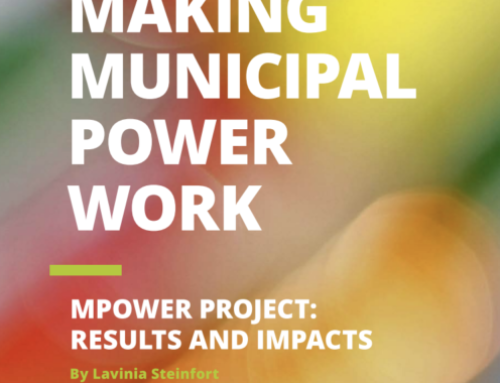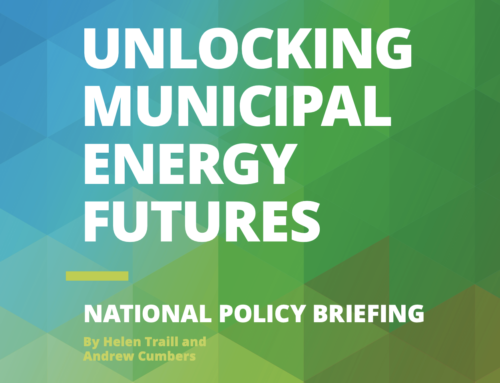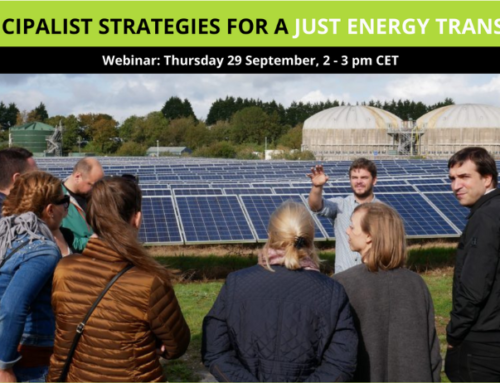The City of Zenica takes action: cleaner air, upgraded public lighting and more efficient heating

By Jakuta Imširović, municipality of Zenica
The City of Zenica is a small town in central Bosnia and Herzegovina known for its heavy industry. Its economy is based on steel and coal production, and it was previously known as the capital of mining and metals within the former Yugoslavia. Today most of its steel is produced by the world’s biggest steel and mining company, ArcelorMittal. This has brought economic benefits over the last three decades, but the heavy metal processing has also degraded Zenica’s air, water and soils.

Zenica is a small city, with around 111,000 people, located in the Bosna river valley, about 70km northwest of Sarajevo. The municipality of Zenica incorporates surrounding villages and small settlements in the hills of the Dinaric Alps. Its typically modest wind speeds and still weather add to the environmental problems faced by Zeneca, because they stop the dispersion of polluting emissions from local heavy industry, energy plants and traffic.

The city is working hard to reduce its dependency on coal, improve energy efficiency and reduce pollution. Current projects include a new thermal power plant that runs on gases produced by the steel plant, improvements to the energy efficiency of public and private buildings and public lighting, and the construction of 18 new roundabouts to reduce traffic pollution. At the same time, new trees are constantly being planted. The city also plays an important role supporting investment in energy efficiency through stakeholder engagement and targeted funding.
Zenica wants to collaborate with other towns, to learn from each other’s best practices in relation to renewable energy and implementing effective solutions. The city is especially keen to hear from other European cities of a similar size that have already made the transition from fossil fuels to renewables and completed energy efficiency projects.
Toplana Zenica: replacing coal with gas
The city’s flagship project is ‘Toplana Zenica’, supported by the European Bank for Reconstruction and Development. Toplana Zenica is a joint venture between ArcelorMittal Zenica (AMZ) from Bosnia and Herzegovina (50%), the City of Zenica (20%), Finnish equipment provider KPA Unicon (15%) and the Finnish Government’s development fund, Finnfund (15%).
The coal-based energy plant on the AMZ site supplies energy to the site itself and heat for the city’s district heating network. It is also responsible for 25% of the steelwork’s pollution. The plant has a rated capacity of 174MW but its actual capacity is limited to around 58MW. This output is not enough to meet the peak heating needs of the district heating system, resulting in some properties being underheated in cold periods, especially the upper floors of apartment buildings. This situation is made worse by large system losses, in part because of poor thermal insulation in pipe networks and buildings.
The Toplana Zenica project will replace the energy plant with modern units that use gases recovered from the steelworks, topped up with fossil gas. The new energy centre will be cleaner, more efficient and more reliable. Its rated output will be 60MW. The project is expected to deliver dramatic reductions in air pollutant emissions – including CO2, dust, NOX and SO2 – of around 90 per cent. Operations are planned to start in the winter of 2020-2021.

Planting trees and creating roundabouts to fight air pollution
Maintaining and restoring Zenica’s stock of trees is also an important way of reducing high levels of air pollution. Trees create a natural barrier discouraging the transfer of pollutants across the city, and are an important source of oxygen in the urban area. Planting and renewing the existing tree stock takes place every year.
In the transport sector, the focus has been on the construction of 18 roundabouts on the main city road, to enhance the flow of traffic and reduce emissions from vehicles that are idling in traffic jams. This will reduce CO2 emissions by an estimated 4,972 tons.
Enhancing Zenica’s district heating system
The city’s district heating network supplies 45 per cent of the city’s heating but the system is very old and in need of investment, refurbishment and expansion (although a small, separate heating network operates in Nemila, in the northern part of Zenica, which is powered by a 3MW biomass boiler fuelled by wood chips and local organic waste).
The district heating company has developed a three-stage strategy to future proof the main network. The first stage is the new energy plant that will be built at the AMZ site. The second stage is the renewal of the district heating network infrastructure. And the third is the planned extension of the network to other parts of the city. A new public enterprise, Zenicagas d.o.o Zenica, will create a local gas network to this end.
Influencing residents to switch to cleaner heating is a key challenge. At the moment renewable energy makes up less than one per cent of the total electricity supply in Zenica. The city is currently considering the best ways of persuading residential owners to switch away from using coal, oil and wood to heat their homes. These include the investments in the district heating network and the extension of the gas network to properties running on solid fuels, combined with funding to support energy efficiency retrofitting. The city is also co-financing the implementation of energy efficiency measures in apartment blocks (matching the investment provided by apartment owners). Measures in the private sector include retrofitting buildings with thermal insulation and roofs. New buildings must now have thermostatic controls as well.

Introducing energy efficiency measures across the city
The city is introducing energy efficiency measures across the public sector too, especially in the city’s public lighting system and in its kindergartens.
In 2014, the city initiated a project to reconstruct and modernise public lighting in urban areas and suburban areas (including 65 villages). The selection of locations most in need of improvement was based on an analysis of the age of the lighting system (over 20 years), frequency of malfunction and electricity consumption. Around 60 per cent of this project was completed in 2014 and the total estimated CO2 emission reduction is 1,255 tons. The city is now converting public lights to LED lighting.
Energy efficiency measures in kindergartens include the installation of thermal façades, the replacement of exterior woodwork, the renovation and thermal insulation of roofs, and improvements to heating systems. These measures enhance the children’s learning environment, as well as contributing to energy and cost savings, freeing up finance for other projects.

Another project to increase renewable energy production is the construction of the 450kW Cajdras hydroelectric power plant by the public Water and Sewerage enterprise. This project has already reduced CO2 emissions by 3,815 tons.

Conclusions
The City of Zenica is continuing its efforts to promote renewable energy technologies and energy efficiency. All significant decisions have involved public discussions with Zenica’s citizens. Annual energy days are also organised to increase awareness about energy efficiency and encourage changes in people’s personal and professional lives. Workshops for children are held in kindergartens and schools.
Further action is still needed however. These include fiscal incentives to facilitate responsible and comprehensive green measures; the installation of heating, ventilation and air conditioning (HVAC) systems; solar systems for hot water and heating; and the further replacement of existing lighting with energy efficient light bulbs – all in line with the principles of the circular economy and green procurement. These are the main areas in which we, as a small city, can benefit from the peer learning facilitated by mPOWER Exchange.
About the author:
Jakuta Imširović is an expert associate for environmental efficiency in the City of Zenica. Born and educated in Zenica, Jakuta graduated from the University of Zenica (Department for Environmental Protection). Besides working for the city’s administration, Jakuta works as a teaching assistant at the University of Zenica and as an expert in environmental protection on several projects with the Institut Kemal Kapetanović.
This blog is part of the mPOWER blog series in which cities and towns share how they are building better energy futures.










